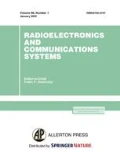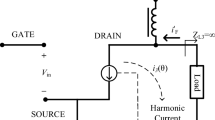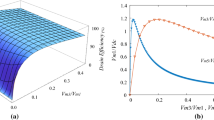Abstract
In this paper we present the technique for development and calculation of the load network for the microwave class F power amplifier (PA) with addition of the third and the fifth voltage harmonics. The suggested load network compensates negative influence of parasitic elements of the transistor (of output capacitance and of output inductance) on the operation of class F PA. Also the load network allows one to decrease the negative influence of some real properties of the supply circuit shunt capacitor and the blocking capacitor on the impedances, which are created by the load network at the transistor chip. We have obtained the calculation formula for the transistor load resistance at the specified output power for class F PA with addition of the third and the fifth voltage harmonics.
Similar content being viewed by others
References
J. H. Kim, G. D. Jo, J. H. Oh, Y. H. Kim, K. C. Lee, J. H. Jung, “Modeling and design methodology of high-efficiency class-F and class-F−1 power amplifiers,” IEEE Trans. Microwave Theory Tech. 59, No. 1, 153 (Jan. 2011), DOI: 10.1109/TMTT.2010.2090167.
M. Wren, T. J. Brazil, “Experimental class-F power amplifier design using computationally efficient and accurate large-signal pHEMT model,” IEEE Trans. Microwave Theory Tech. 53, No. 5, 1723 (May 2005), DOI: 10.1109/TMTT.2005.847108.
J. Moon, S. Jee, J. Kim, J. Kim, B. Kim, “Behaviors of class-F and class-F−1 amplifiers,” IEEE Trans. Microwave Theory Tech. 60, No. 6, 1937 (Jun. 2012), DOI: 10.1109/TMTT.2012.2190749.
V. Vadala, A. Raffo, S. Di Falco, G. Bosi, A. Nalli, G. Vannini, “Load-pull characterization technique accounting for harmonic tuning,” IEEE Trans. Microwave Theory Tech. 61, No. 7, 2695 (Jul. 2013), DOI: 10.1109/TMTT.2013.2262803.
K. Kuroda, R. Ishikawa, K. Honjo, “Parasitic compensation design technique for a C-band GaN HEMT class-F amplifier,” IEEE Trans. Microwave Theory Tech. 58, No. 11, 2741 (Nov. 2010), DOI: 10.1109/TMTT.2010.2077951.
A. Grebennikov, “Load network design technique for class F and inverse class F PAs,” High Frequency Electronics 10, No. 5, 58 (2011), http://www.highfrequencyelectronics.com/May11/HFE0511_Grebennikov.pdf.
A. P. Yefymovych, V. G. Krizhanovski, “The methods of compensating parasitic elements of the transistor in class-F amplifier at the microwave range,” Proc. of Int. Conf. on Microwave and Telecommunication Technology, CriMiCo-2013, 8–13 Sept. 2013, Sevastopol, Ukraine (Sevastopol, 2013), pp. 98–99.
A. P. Yefymovych, V. G. Krizhanovski, “Compensation of parasitic elements of transistor in the class F amplifier with the tuning of impedances at harmonics,” Technology and Designing of Electronic Equipment 1, 3 (2014).
A. Yefymovych, V. Krizhanovski, R. Giofre, P. Colantonio, “Load network design technique for microwave class-F amplifier,” Proc. of XX Int. Conf. of Microwaves on Radar and Wireless Communications, MIKON-2014, 16–18 June 2014, Poland, Gdansk (IEEE, 2014), pp. 439–441, DOI: 10.1109/MIKON.2014.6899939.
Kenle Chen, Dimitrios Peroulis, “Design of broadband highly efficient harmonic-tuned power amplifier using in-band continuous class-F−1/F mode transferring,” IEEE Trans. Microwave Theory Tech. 60, No. 12, 4107 (Dec. 2012), DOI: 10.1109/TMTT.2012.2221142.
G. Nikandish, E. Babakrpur, A. Medi, “A harmonic termination technique for single- and multi-band high-efficiency class-F MMIC power amplifiers,” IEEE Trans. Microwave Theory Tech. 62, No. 5, 1212 (May 2014), DOI: 10.1109/TMTT.2014.2315591.
F. H. Raab, “Maximum efficiency and output of class-F power amplifiers,” IEEE Trans. Microwave Theory Tech. 49, No. 6, 1162 (Jun. 2001), DOI: 10.1109/22.925511.
How can the mounting area be reduced? Methods of using low-ESL capacitors, http://www.murata.com.
A. N. Rudiakova, “BJT class-F power amplifier near transition frequency,” IEEE Trans. Microwave Theory Tech. 53, No. 9, 3045 (Sept. 2005), DOI: 10.1109/TMTT.2005.854217.
P. Colantonio, F. Giannini, E. Limiti, High Efficiency RF and Microwave Solid State Power Amplifiers (Wiley, New York, 2009).
CGH60008D, http://www.datasheetarchive.com/CGH60008D/Datasheets-IS8/DSA00153652.html.
S. C. Cripps, RF Power Amplifiers for Wireless Communications, 2nd ed. (Artech House, Boston, 2006), 456 p.
T. Canning, P. J. Tasker, S. C. Cripps, “Continuous mode power amplifier design using harmonic clipping contours: Theory and practice,” IEEE Trans. Microwave Theory Techniques 62, No. 1, 100 (Jan. 2014), DOI: 10.1109/TMTT.2013.2292675.
Author information
Authors and Affiliations
Corresponding author
Additional information
Original Russian Text © A. Yefymovych, V.G. Krizhanovski, V. Kovalenko, R. Giofrè, P. Colantonio, R. Danieli, 2015, published in Izv. Vyssh. Uchebn. Zaved., Radioelektron., 2015, Vol. 58, No. 7, pp. 3–17.
ORCID: 0000-0002-2685-9740
ORCID: 0000-0002-7503-0373
ORCID: 0000-0002-5788-1262
About this article
Cite this article
Yefymovych, A., Krizhanovski, V.G., Kovalenko, V. et al. Load network for microwave class F amplifier. Radioelectron.Commun.Syst. 58, 291–303 (2015). https://doi.org/10.3103/S0735272715070018
Revised:
Published:
Issue Date:
DOI: https://doi.org/10.3103/S0735272715070018




